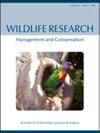Is regional variability in environmental conditions driving differences in the early body condition of endemic Australian fur seal pups?
IF 1.6
3区 生物学
Q3 ECOLOGY
引用次数: 1
Abstract
ABSTRACT Context. Good body condition in juvenile marine mammals is crucial for survival and, therefore, population demography. Australian fur seals, endemic to Australia, recently established a breeding colony at the southern edge of their range, at The Needles, a small group of islands in south-west Tasmania (43.6614°S) and a significant distance from their core breeding range in Bass Strait. Aims. We aimed to compare pup body condition at two breeding colonies, distinct in time since establishment and latitude. Specific aims were to: (1) establish the timing of peak pupping, to compare condition of known-age pups, and determine a baseline at The Needles; (2) investigate pup body condition over time at an established colony; and (3) gain insight into the effects of environmental conditions on pup body condition. Methods. We conducted a colony comparison of pup body condition using condition indices at The Needles and an established breeding colony in Bass Strait, Tenth Island, for the 2019/20 and 2020/21 breeding seasons. Pup body condition was quantified at Tenth Island over 18 years (2003–2020) using a long-term morphometric dataset. To establish breeding phenology at these two colonies, we determined peak pupping date for the 2019/20 breeding season using daily pup counts. We assessed the effect of environmental parameters on body condition for the long-term dataset. Key results. Pups from The Needles displayed significantly higher body condition than those from Tenth Island, despite similar peak pupping date. Breeding phenology was consistent with published timing for Australian fur seals. Pup body condition at Tenth Island over the 2-year colony comparison was comparable to the historical average. Environmental drivers that affect maternal foraging efficiency are linked to pup body condition. Conclusions. Higher pup body condition at The Needles is likely underpinned by better foraging conditions resulting in increased pup provisioning levels. Our results indicate that south-west Tasmania is a region of foraging and emerging breeding importance for Australian fur seals. Implications. Future research to monitor pup body condition, maternal foraging behaviour and ecosystem productivity at The Needles will help to provide greater understanding of likely population trajectories at this southernmost breeding site for Australian fur seals.环境条件的区域差异是否导致了澳大利亚特有海狗幼仔早期身体状况的差异?
本文章由计算机程序翻译,如有差异,请以英文原文为准。
求助全文
约1分钟内获得全文
求助全文
来源期刊

Wildlife Research
生物-动物学
CiteScore
4.30
自引率
15.80%
发文量
56
审稿时长
3 months
期刊介绍:
Wildlife Research represents an international forum for the publication of research and debate on the ecology, management and conservation of wild animals in natural and modified habitats. The journal combines basic research in wildlife ecology with advances in science-based management practice. Subject areas include: applied ecology; conservation biology; ecosystem management; management of over-abundant, pest and invasive species; global change and wildlife management; diseases and their impacts on wildlife populations; human dimensions of management and conservation; assessing management outcomes; and the implications of wildlife research for policy development. Readers can expect a range of papers covering well-structured field studies, manipulative experiments, and analytical and modelling studies. All articles aim to improve the practice of wildlife management and contribute conceptual advances to our knowledge and understanding of wildlife ecology.
Wildlife Research is a vital resource for wildlife scientists, students and managers, applied ecologists, conservation biologists, environmental consultants and NGOs and government policy advisors.
Wildlife Research is published with the endorsement of the Commonwealth Scientific and Industrial Research Organisation (CSIRO) and the Australian Academy of Science.
 求助内容:
求助内容: 应助结果提醒方式:
应助结果提醒方式:


